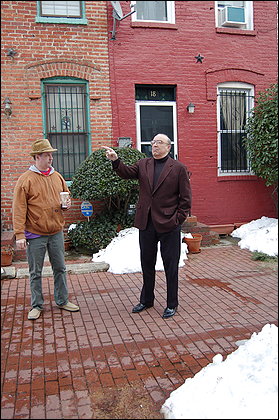DC Alley Residents Unite!

Adam Clayton Powell III, right, chats with resident Will Fleishell, a.k.a. "the Mayor of Gessford Court." Photo Credit: Elizabeth Festa For The Washington Post.
Today's Washington Post real estate section "neighborhood" article, "DC's Gessford Court is a little alley oasis" features the Gessford Court Alley of Capitol Hill, and Will Fleishell, a resident there, who co-founded the group, DC Alley Dwellers Alliance (DADA). Will has helped lead tours of Capitol Hill alleys that I have done for the past few years. (But I might not be doing any alley tours this year. Too much work.) DADA has a yahoo group (alleyresidents) that people can join.
This is the DADA manifesto:
Our aim is to improve the conditions of both owners and renters who live in D.C.'s inhabited alleys. Citizens living in D.C.'s alley areas have suffered from neglect and stigmatization by both the city government and street dwelling neighbors. This shameful history must come to an end. Alleys are now desirable places to live, no longer harbingers or breeding grounds for crime and decay.
Alley inhabitants have struggled for years to bring attention to our attempts to improve the appearance and condition of our homes and properties. The only way to address the official apathy and to encourage a positive and beneficial response to our needs is to band together to fight for our betterment. Citizens of D.C.'s alleys should not have to live the lives of a second class or diminished attention while we pay some of the highest municipal tax rates in the U.S.A.
Alleys should be for people – not just for cars and parking!
Some issues for discussion and consideration with regards to alley and those who inhabit them:
Infrastructure, Mobility, and Quality of Life
• Re-bricking and improvement of alley surfaces/updated utilities
• Traffic Safety – Installation of mirrors, speed limit signs and traffic calming measures for alleys. Belgian block as a paving material to naturally slow speeds.
• Illegal parking in alleys – lack of enforcement by Police and Parking Enforcement
• Encourage pedestrian/alternative transportation for alleys - Why don't we have bike racks for alleys?
• Install better street signage for alleys
• Beautification of alleys with plants or public art
• Social gatherings for alley dwellers. Why is it illegal for alleys to be closed for block celebrations while streets are allowed to close for the same?
• Produce a census/map of occupied alleys of D.C. (OCTO, DOT)
Government Services
• Poor police response because alley locations are not listed correctly in police computers (MPD, Unified Communications Center, OCTO street database)
• Most inhabited alleys NEVER see snow removal (DDOT, DPW)
• No new garbage cans have been provided for alley dwellers (DPW)
• Illegal dumping in alleys. This is a frequent problem. Can we increase fines for dumping in inhabited alleys?
• Illegal parking in alleys – lack of enforcement by MPD and DPW Parking Enforcement
• Pest and Termite abatement (Alley houses suffer greatly from this problem- why not a city sponsored termite/pest control effort? -- DOH)
Alley expansion and residential use
• Residential use has been made illegal in the current zoning code, because of the extremely narrow width of most alleys.
• Adding more residents to alleys will add more people and density in ways that strengthen alley neighborhoods, street-fronting residential areas, and the city at large, by providing more affordable living and work spaces and by putting additional eyes into our alleyways (what Jane Jacobs called “eyes on the street”)
• Therefore, expand residential use and appropriate, tasteful development in alleys.
• Change the zoning rules to allow old alley buildings to be used as residences, and new alley buildings--residential, shops/studios and/or mixed use—to be constructed
• … but without the mandatory parking requirements set forth in the current Zoning codes
• Zoning regulations should be amended so that our street-fronting neighbors and property owners can build apartments or offices above existing garages (and/or on the rear of lots where appropriate).
Labels: alleys, urban design/placemaking, zoning



0 Comments:
Post a Comment
<< Home